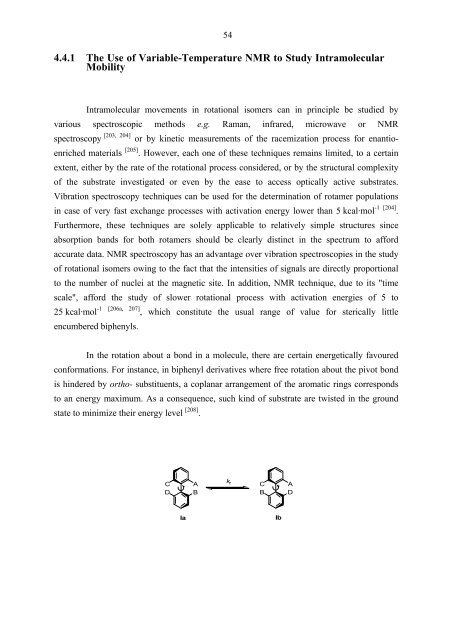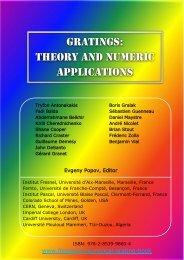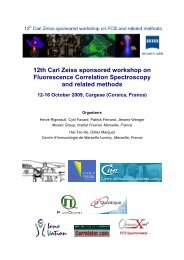My PhD dissertation - Institut Fresnel
My PhD dissertation - Institut Fresnel
My PhD dissertation - Institut Fresnel
You also want an ePaper? Increase the reach of your titles
YUMPU automatically turns print PDFs into web optimized ePapers that Google loves.
4.4.1 The Use of Variable-Temperature NMR to Study Intramolecular<br />
Mobility<br />
54<br />
Intramolecular movements in rotational isomers can in principle be studied by<br />
various spectroscopic methods e.g. Raman, infrared, microwave or NMR<br />
spectroscopy<br />
enriched materials<br />
[ , ] 203 204 or by kinetic measurements of the racemization process for enantio-<br />
[ ] 205 . However, each one of these techniques remains limited, to a certain<br />
extent, either by the rate of the rotational process considered, or by the structural complexity<br />
of the substrate investigated or even by the ease to access optically active substrates.<br />
Vibration spectroscopy techniques can be used for the determination of rotamer populations<br />
in case of very fast exchange processes with activation energy lower than 5 kcal·mol -1 [204] .<br />
Furthermore, these techniques are solely applicable to relatively simple structures since<br />
absorption bands for both rotamers should be clearly distinct in the spectrum to afford<br />
accurate data. NMR spectroscopy has an advantage over vibration spectroscopies in the study<br />
of rotational isomers owing to the fact that the intensities of signals are directly proportional<br />
to the number of nuclei at the magnetic site. In addition, NMR technique, due to its "time<br />
scale", afford the study of slower rotational process with activation energies of 5 to<br />
-1 [ a, ]<br />
25 kcal·mol 206 207 , which constitute the usual range of value for sterically little<br />
encumbered biphenyls.<br />
In the rotation about a bond in a molecule, there are certain energetically favoured<br />
conformations. For instance, in biphenyl derivatives where free rotation about the pivot bond<br />
is hindered by ortho- substituents, a coplanar arrangement of the aromatic rings corresponds<br />
to an energy maximum. As a consequence, such kind of substrate are twisted in the ground<br />
state to minimize their energy level<br />
C<br />
D<br />
[ ] 208 .<br />
A<br />
B<br />
k r<br />
C<br />
B<br />
Ia Ib<br />
A<br />
D













